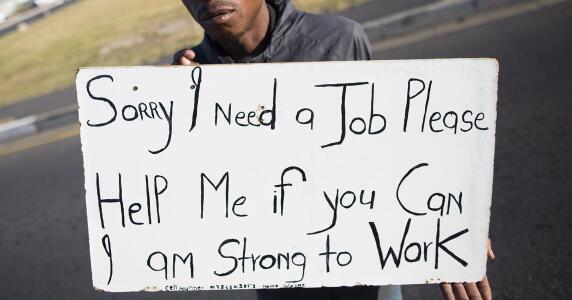Data from Statistics South Africa (Stats SA) on Tuesday showed 278,000 more people joined the ranks of the unemployed in the last three months of 2021, raising the jobless rate to yet another record high.
SOUTH Africa’s unemployment rate is likely to remain the highest in the world for the foreseeable future as economic woes force the number of jobs created to be outpaced by the size of the labour market.
Data from Statistics South Africa (Stats SA) on Tuesday showed 278,000 more people joined the ranks of the unemployed in the last three months of 2021, raising the jobless rate to yet another record high.
Stats SA said the country’s unemployment rate rose by 0.4 of a percentage point to reach the dreaded 35.3 percent in the fourth quarter, up from 34.9 percent the previous quarter.
This means that there were 7.9 million people of working age actively looking for work who had no jobs at the end of 2021, up from 7.6 million in the previous quarter.
That number jumps to 12.5 million people when including discouraged work-seekers.
Statistician-general Risenga Maluleke, releasing the Quarterly Labour Force Survey (QLFS), said though 262,000 jobs were created and increasing the workforce to 14.5 million, these jobs were outnumbered by the population that joined the unemployed ranks.
“Unemployment has been steadily rising, from about 25 percent a decade ago,” Maluleke said.
Economists said the unemployment rate rose the highest as 56,000 discouraged job-seekers returned to the labour force on signs of improved economic activity, outpacing the number of jobs on offer.
Youth unemployment remained a major problem as the population aged 15 and 24 years recorded the highest unemployment rate of 66.5 percent in the fourth quarter.
This was followed by 43.5 percent for the group 25 to 34 years.
Investec economist Lara Hodes said the government should make good on measures to boost job creation as outlined in the State of the Nation address last month.
“Indeed, a focus on improving the quality of and access to education remains essential,” Hodes said.
The industry breakdown showed that the most jobs were lost in the informal sector which shed 48,000 jobs, while formal sector employment went up by 143,000 jobs in the same period.
Manufacturing, construction, utilities and transport reduced employment weighed by power shortages and subdued fixed investment while mining, agriculture added jobs.
Employment in agriculture increased by 38,000 jobs quarter on quarter, from 829,000 jobs to 868,000 in the fourth quarter.
Agri SA labour and employment specialist Lebohang Sethusha said despite this, the sector’s growth continued to be stifled by poor infrastructure such as road, rail and ports, among many other challenges like rising input costs.
The unemployment rate, according to the expanded definition of unemployment, eased by 0.4 of a percentage point to 46.2 percent in the fourth quarter.
Nedbank economist Johannes Khosa said the outlook for the job market remained uncertain, in spite of the easing of lockdown restrictions and ongoing economic reforms which should lift business confidence and support employment growth.
“However, the unemployment rate will remain structurally high in the short term because the economy is still facing many long-term challenges that are hindering jobs growth,” Khosa said.
“Some of the fundamental structural deficiencies, such as electricity shortages and policy challenges, will take years to resolve, which will contain growth in private sector investment.
“All these factors will keep the unemployment rate elevated throughout 2022.”
– BUSINESS REPORT








